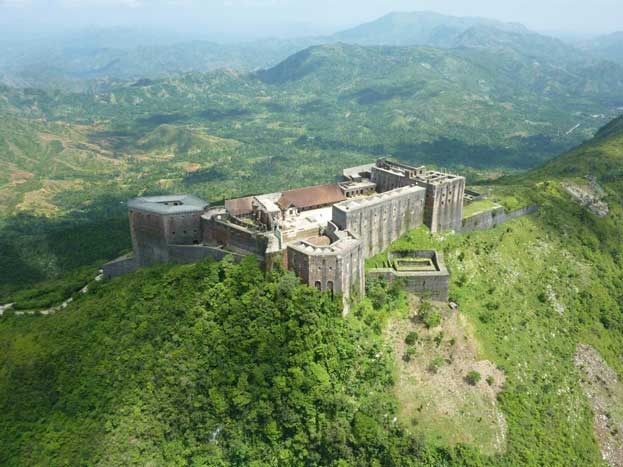This property of National History Park – Citadel, Sans Souci, Ramiers, Haiti, is an eminent example of a type of structure illustrating the historical situation of Haiti at the dawn of its independence. These Haitian monuments date from the beginning of the 19th century, when Haiti proclaimed its independence. The Palace of Sans Souci, the buildings at Ramiers, and, in particular, the Citadel serve as universal symbols of liberty, being the first monuments to be constructed by black slaves who had gained their freedom.

Continent: North America
Country: Haiti
Category: Cultural
Criterion: (IV)(VI)
Date of Inscription: 1982
National History Park
The heritage site is situated within the National History Park created by presidential decree in 1978; in a splendid natural setting of mountainous peaks covered with luxuriant vegetation, the Citadelle Henry, the Site des Ramiers, and the Palais San-Souci represent for the Haitians the first monuments of their independence.On 1 January 1804, after 14 years of struggle by the island's black slaves against the colonists, Jean-Jacques Dessallines, the principal leader of the revolution, proclaimed the independent Republic of Haiti. The Emperor Dessallines immediately entrusted to Henry Christophe, one of his generals, the task of constructing an immense fortress on the Pic Laferrière, or Pic Henry, 28 km south-west of Cap Haitien.
 |
| Citadelle Laferriere Haiti |
Browse Gallery Plus UNESCO Storyline
At the death of Dessallines in 1806, the Haitian Republic was divided into two states: the southern part governed by Pétion, and the north, where Christophe proclaimed himself king in 1811. The Citadelle Henry originally conceived as the monument to the defence of liberty was maintained as a fortress by the despot and was inaugurated only in 1813.
At the same time, King Christophe (Henry I) undertook the construction of an astonishing palace surrounded by gardens, situated at the foot of the access road to the citadel near the village of Milot. The Palais Sans-Souci, mainly in a state of ruin but currently being restored, owes its bizarre beauty to an exceptional harmony with the mountainous setting, as well as its recourse to diverse and yet reputedly irreconcilable architectural models. The Baroque staircase and the classical terraces, the stepped gardens reminiscent of Potsdam and Vienna, the canals and basins freely inspired by Versailles, impart an indefinable hallucinatory quality to the creation of the megalomaniac king.
Both military installation and political statement, the Citadelle Henry, constructed at an altitude of 970 m and covering a surface area of about 1 ha, is one of the best examples of the art of military engineering of the early 19th century. The plans are the work of the Haitian Henri Barré, but it is probable that General Christophe played the preponderant role in their formulation: the projecting masses remarkably articulated to allow an integrated use of artillery capabilities; an elaborate system of water supply and cisterns; and colossal defensive walls which render this citadel impregnable. It can shelter a garrison of 2,000 men, or 5,000 if necessary.
Browse All UNESCO World Heritage Sites in
Haiti. The original UNESCO inscription
Here!!!











No comments:
Post a Comment